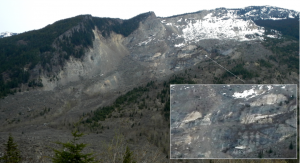Chapter 15. Mass Wasting
Adapted by Joyce M. McBeth, University of Saskatchewan
from Physical Geology by Steven Earle
Chapter Goals
Complete this chapter so you can:
- Explain how slope stability is related to slope angle
- Summarize some of the factors that influence the strength of materials on slopes, including the type of rock, the presence and orientation of planes of weakness such as bedding planes or fractures, the type of unconsolidated material upon the slope, and the effects of water flowing upon or within the slope material
- Explain what types of events can trigger mass wasting
- Summarize the types of motion that can happen during mass wasting
- Describe the difference between a translational and a rotational slope failure
- Describe the main types of mass wasting — creep, slump, slide, fall, and debris or mud flow — in terms of the types of materials involved, the type of motion, and the likely rates of motion
- Explain what steps we can take to delay mass wasting, and why we cannot prevent it permanently
- Describe some of the measures that can be taken to mitigate the risks associated with mass wasting
Introduction
Mass movement, mass wasting, and slope failure are all terms used to refer to materials moving down a slope because of the force of gravity. The term landslide is also used colloquially to refer to mass movement. The types of materials that move can be anything from mud to house-sized slabs of rock, to snow. The materials may move very slowly over years so that change is barely perceptible, or the movement might take only seconds.
The Hope Slide: a Historic Canadian Example of a Mass Wasting Event
Early in the morning of January 9, 1965, 47 million cubic metres of rock broke away from the steep upper slopes of Johnson Peak (16 km southeast of Hope, B.C.) and tumbled 2,000 m down the mountain, gouging out the contents of a small lake at the bottom, and continuing a few hundred metres up the other side of the valley (Figure 15.1). Four people who had been stopped on the highway by a snow avalanche were killed. Many more people might have become victims, except that a Greyhound bus driver en route to Vancouver turned his bus around upon seeing the avalanche.

The rock failed along foliation planes of the metamorphic rock on Johnson Peak, in an area that had been eroded into a steep slope by glacial ice. There’s no evidence that it was triggered by any specific event, and there was no warning that it was about to happen. Even if there had been warning, nothing could have been done to prevent it. There are hundreds of similar sites throughout mountainous regions of British Columbia and elsewhere in Canada where large mass wasting events could occur.
What can we learn from the Hope Slide? In general, we cannot prevent most mass wasting events, and significant effort is required if an event is to be predicted with any level of certainty. Understanding the geology is critical to understanding mass wasting. Although slope failures are inevitable in a region with steep slopes, larger slope failures happen less frequently than smaller ones. The consequences of a large mass wasting event also vary depending on the downslope conditions, such as the presence of people, buildings, roads, or fish-bearing streams.
An important reason for learning about mass wasting is to understand the nature of how and why materials fail in mass wasting events. If we understand this better, we can use this knowledge to help minimize the risks from similar events in the future.

